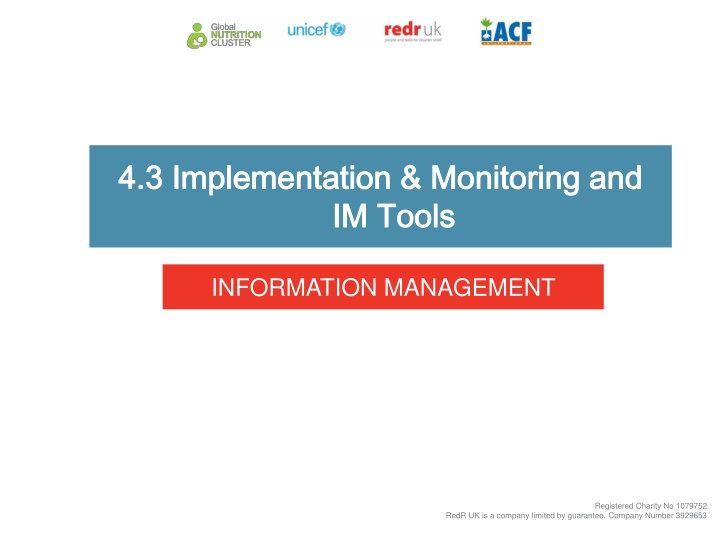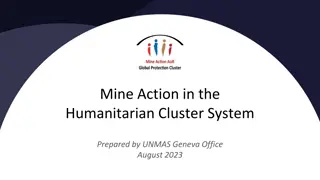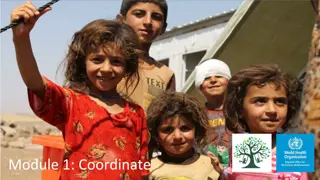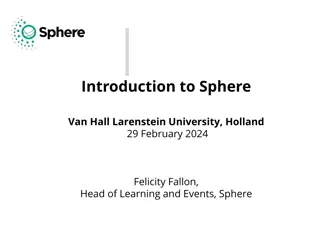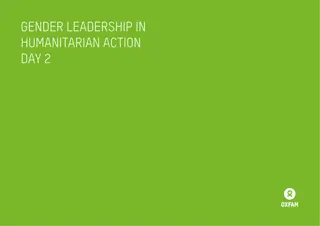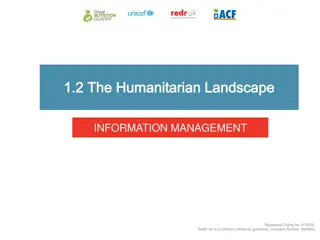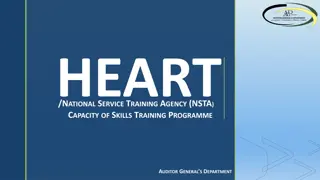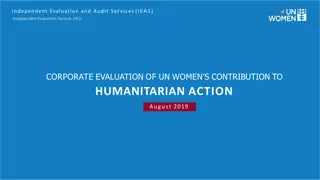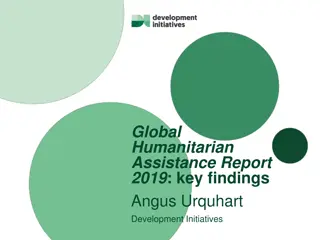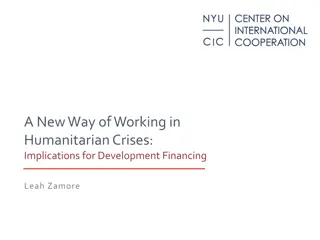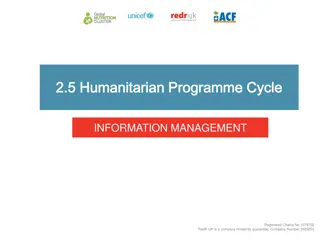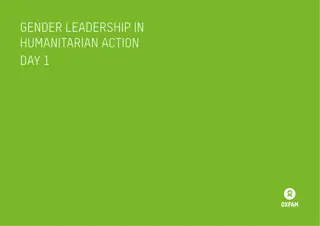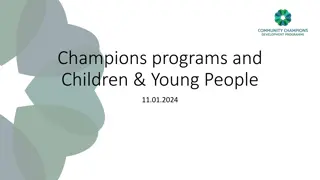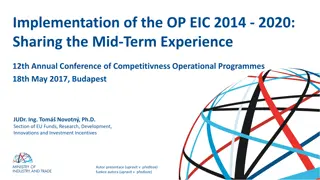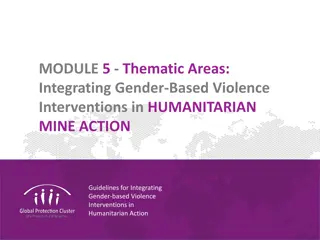Challenges in Monitoring and Implementation of Humanitarian Programmes
Monitoring is essential in humanitarian programmes to document progress, ensure accountability, and make timely decisions. However, challenges such as poor linkage between monitoring tools, inadequate stakeholder participation, and corruption hinder effective response monitoring. Addressing these challenges requires improved information management processes and tools.
Download Presentation

Please find below an Image/Link to download the presentation.
The content on the website is provided AS IS for your information and personal use only. It may not be sold, licensed, or shared on other websites without obtaining consent from the author.If you encounter any issues during the download, it is possible that the publisher has removed the file from their server.
You are allowed to download the files provided on this website for personal or commercial use, subject to the condition that they are used lawfully. All files are the property of their respective owners.
The content on the website is provided AS IS for your information and personal use only. It may not be sold, licensed, or shared on other websites without obtaining consent from the author.
E N D
Presentation Transcript
4.3 4.3 Implementation & Monitoring and Implementation & Monitoring and IM Tools IM Tools INFORMATION MANAGEMENT Registered Charity No 1079752 RedR UK is a company limited by guarantee. Company Number 3929653
Monitoring is the systematic and continuous process of collecting and usinginformation throughout the humanitarian programme cycle for management and decision-making
Why do we monitor? to document progress and results against cluster targets to provide the necessary information to cluster for timely decision taking and corrective action (if necessary) to promote accountability to all stakeholders (to affected population, donors, partners etc)
Exercise: Challenges to monitoring Based on your experience in the nutrition cluster: What information management processes and tools are currently being used to support monitoring? What are three key challenges to effective response monitoring? What could the IM do to address those challenges?
Common challenges Poor linkage (situation monitoring & standard indicator) Inadequate participation of NC partners & affected communities Duplication Difficulty in agreement (tools/approaches) Corruptions and misconducts by the partners and stakeholders Lack of capacity to address PSEA and GBV protection and prevention by the response system Inadequate or wrong baseline data that are often gender and GBV blind
Acute malnutrition A result of recent (short-term) deficiency of protein, energy, and minerals and vitamins leading to loss of body fats and muscle tissues. Acute malnutrition presents with wasting (low weight-for-height) and/or the presence of oedema (i.e., retention of water in body tissues).
Severe acute malnutrition Defined for children aged 6 59 months, as a weight-for-height below 3 standard deviations from the median weight-for-height for the standard reference population or a mid-upper arm circumference of less than 115 mm or the presence of nutritional oedema or marasmic- kwashiorkor.
Moderate acute malnutrition Defined for children aged 6 59 months as weight-for-height between minus two and minus three standard deviations from the median weight-for-height for the standard reference population and no nutritional oedema or marasmic-kwashiorkor.
Additional data for monitoring CMAM interventions Derived from routine monitoring and other sources: Sources of data: Registration books Individual follow up charts Interviews and Focus group discussions Observation, home-visits Average length of stay Average weight gain Relapse rate Distribution of admissions per type, per age, per origin Causes of death Reasons for defaulting Investigation of non-recovery cases
Methods and tools for monitoring IYCF interventions Monthly / weekly reporting: Reporting needs to be done per site (service unit) and compiled per area (district ) up to the national level Routine supervision Surveys to determine situation and change in IYCF practices BMS code violations monitoring
Pregnant women attended individual counselling sessions Individual sessions (one-to-one) Lactating women and caretakers of children <6 months attended individual counselling sessions Indicators for monitoring IYCF-E interventions Lactating women and caretakers of children 6-24 months attended individual counselling sessions Number of IYCF groups (including mother support groups) operations during the (time period) Total number of group sessions (including mother support groups)held during the (time period) New admission of PLW and caretakers in IYCF groups (including mother support groups during the (time period) Male IYCF Female Total number of PLW caretakers attending IYCF groups (including mother support groups during the (time period) Male Female
Total number of infants 0-6 months require artificial feeding who have received BMS and appropriate support during the (time period) Artificial feeding Total number of infants 6-24 months who require artificial feeding you have received BMS and appropriate support during the (time period) Total number of breastfeeding corners/baby friendly spaces opened during the (time period) Breastfeeding corners/Baby friendly spaces Number of breastfeeding corners/baby friendly spaces operational during the (time period) New admissions to breastfeeding mothers during the (time period) Total number of breastfeeding mothers attended breastfeeding corners/baby friendly spaces during the (time period)
Methods and tools for monitoring micronutrient interventions Monthly / weekly reporting: Reporting needs to be done per site (service unit) and compiled per area (district ) up to the national level Surveys to determine coverage and situation Campaign reports / administrative reports (i.e. child health days, EPI reports, etc.)
Indicators for monitoring micronutrient interventions Number of boys/girls/PLW (specify age groups) received supplementation (specify) during the reporting period
What GNC IM Tools inform the Implementation & Monitoring stage? Key HRP tips datasets BMS Code Violations tracking Partners tracking tool 4W Country bulletin template HIR IM Map IM Update template examples/ templates Checklist
What GNC IM Tools inform the Implementation & Monitoring stage? Key HRP tips datasets BMS Code Violations tracking Partners reporting tool 4W Country bulletin template HIR IM Map IM Update template examples/ templates Checklist
Breast Milk Substitutes Code violations tracking tool The purpose of the tool is to increase consistency in tracking code violations for improved communication and comparative analysis. Establish SEA and GBV case information sharing protocol with all relevant actors to increase response effectiveness Two-part tool: 1. An adaptable MS Word document for tracking violations of the International Code of Marketing of Breastmilk Substitutes and 2. An MS Excel database to compile code violations for further consolidation, analysis and follow-up Partners complete it initially, either in Word or Excel. Note: It is important that the identity of reporting organization s is kept confidential. It is recommended to conduct capacity building sessions before using this tool.
BMS Code Monitoring Breast Milk Substitutes (BMS) are defined as: "any food being marketed or otherwise represented as partial or total replacement of breast-milk, whether or not suitable for that purpose. "In emergencies, targeting and use, procurement, management and distribution of BMS, milk products, bottles and teats should be strictly controlled based on technical advice, and comply with the International Code and all relevant WHA Resolutions (4)
Partners reporting Partners reporting INFORMATION MANAGEMENT Registered Charity No 1079752 RedR UK is a company limited by guarantee. Company Number 3929653
Partners reporting tool An adaptable Excel template for partner reporting. The template includes various possible interventions and suggested indicators to monitor and should be adapted to the country plans. Records information about nutrition services delivery including general information, screening and referrals, management of SAM (inpatient and outpatient), targeted and blanket supplementary feeding, micronutrients supplementation, deworming, IYCF-E and capacity development. The tool is completed first by partners and then collated and analysed by the IMO. Users may adapt the spreadsheet by hiding row/columns that do not apply to their service provision, however the data extraction sheet should remain fixed.
Exercise: Partners reporting tool Open the M&E Framework your group developed during the Strategic Planning session as the data for this exercise. Practice completing the Partners reporting tool 20 minutes
